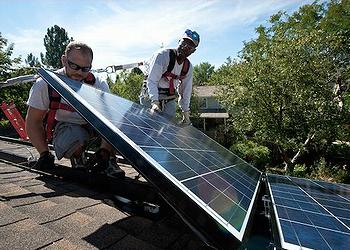
STANFORD, California, April 8, 2013 (ENS) – The rapid growth of the solar power industry over the past 10 years may have worsened the global warming situation it was meant to ease, as the energy used to manufacture the millions of solar panels now generating electricity around the world came from burning fossil fuels.
Stanford University researchers have calculated that imbalance is now history and the global PV industry could pay off its debt of energy as early as 2015, and no later than 2020.

For the first time, the electricity generated by all of the world’s installed solar photovoltaic panels last year “probably surpassed the amount of energy going into fabricating more modules,” said Michael Dale, a postdoctoral fellow at Stanford’s Global Climate & Energy Project, GCEP.
“This analysis shows that the industry is making positive strides,” said Dale, who developed an innovative way of assessing the industry’s progress globally in a study published in the current edition of the journal “Environmental Science & Technology.”
“Despite its fantastically fast growth rate, PV is producing, or just about to start producing, a net energy benefit to society,” said Dale.
Global photovoltaic installations are forecast to exceed 35 gigawatts in 2013, equivalent to growth of 12 percent, according to recently released analysis from IHS, an energy information consultancy. The IHS analysis shows that global PV installations grew 14 percent to reach 31.4 GW last year.
The PV industry has run an energy deficit from 2000 to now, consuming 75 percent more energy than it produced just five years ago. The researchers expect this energy debt to be paid off as early as 2015, due to declining energy inputs, more durable panels and more efficient conversion of sunlight into electricity.
Co-author Sally Benson, GCEP’s director, said the changing energy balance is due to the declining amount of energy required to manufacture and install PV systems.
“GCEP is focused on developing game-changing energy technologies that can be deployed broadly. If we can continue to drive down the energy inputs, we will derive greater benefits from PV,” Benson said. “Developing new technologies with lower energy requirements will allow us to grow the industry at a faster rate.”
The energy used to produce solar panels is intense, explains Mark Golden of Stanford’s Precourt Energy Efficiency Center. “The initial step in producing the silicon at the heart of most panels is to melt silica rock at 3,000 degrees Fahrenheit using electricity, commonly from coal-fired power plants.”
But as investment and technological development have risen with the number of installed panels, the energetic costs of new photovoltaic modules have declined, Golden says.
Thinner silicon wafers are now used to make solar cells, less highly refined materials are now used as the silicon feedstock, and less of the costly material is lost in the manufacturing process.
The efficiency of solar cells using thin film technologies that rely on earth-abundant materials such as copper, zinc, tin and carbon offers the potential for greater improvements.
To be considered a success, or simply a positive energy technology, PV panels must pay back all the energy that went into them, said Dale.
If current rapid growth rates persist, by 2020 about 10 percent of the world’s electricity could be produced by PV systems.
At today’s energy payback rate, producing and installing the new PV modules would consume around nine percent of global electricity. But, if the energy intensity of PV systems continues to drop at its current learning rate, then by 2020 less than two percent of global electricity will be needed to sustain growth of the industry, the Stanford researchers project.
Continued reduction of the energetic costs of producing PV panels can be accomplished by using less materials or switching to producing panels that have much lower energy costs than technologies based on silicon.
The study’s data covers the various silicon-based technologies as well as newer ones using cadmium telluride and copper indium gallium diselenide as semiconductors. Together, these types of PV panels account for 99 percent of installed panels.
The energy payback time can also be reduced by installing PV panels in locations with high quality solar resources, like the desert Southwest in the United States and the Middle East. “At the moment, Germany makes up about 40 percent of the installed market, but sunshine in Germany isn’t that great,” Dale said. “So from a system perspective, it may be better to deploy PV systems where there is more sunshine.”
The PV industry’s energetic costs can differ from its financial costs. Installation and the components outside the solar cells, such as wiring and inverters, as well as soft costs like permitting, account for a third of the financial cost of a solar PV system, but only 13 percent of the energy inputs. The industry is focused primarily on reducing financial costs.
The researchers say this accounting of energetic costs and benefits should be applied to any new energy-producing technology, as well as to energy conservation strategies that have large upfront energetic costs, such as retrofitting buildings. They already have begun to apply the analysis to energy storage and wind power.
Copyright Environment News Service (ENS) 2013. All rights reserved.
